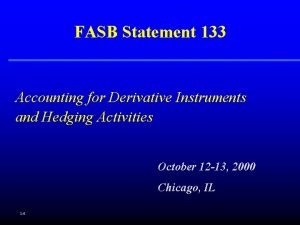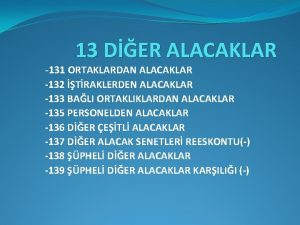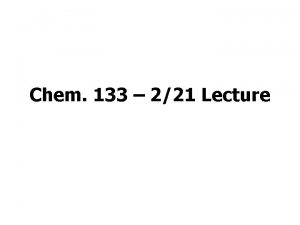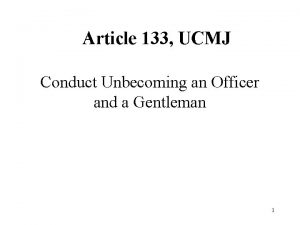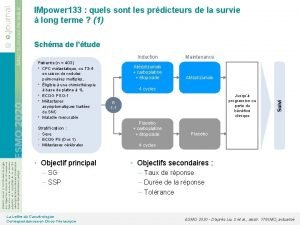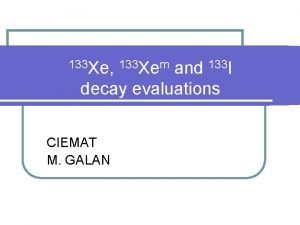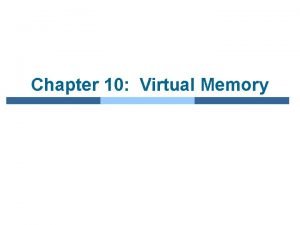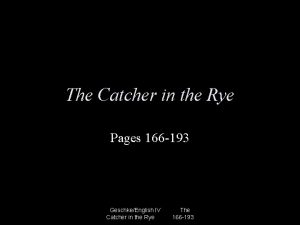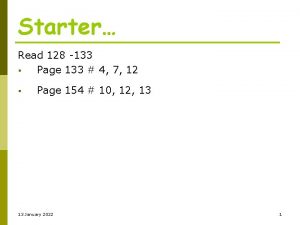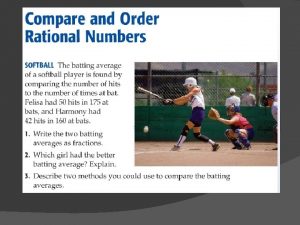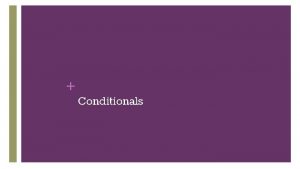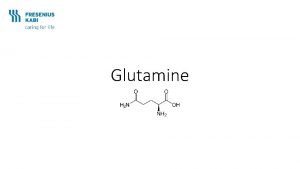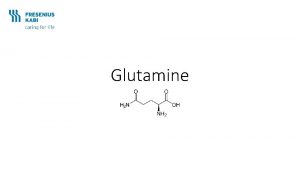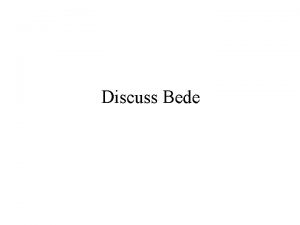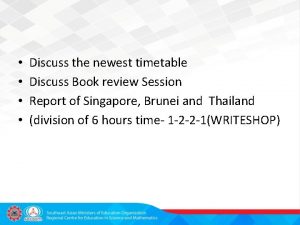1 Copy Notes 2 Notes discuss pages 133





























- Slides: 29

1. ) Copy Notes 2. ) Notes & discuss pages 133 -138 3. ) Answer 3. 1 -3. 4 3. 1 Chapter 3 -Experiments 3. 1 Designing Experiments Experiment – A procedure for investigating the effect of an experimental condition on a response variable. Experimental units – Individuals on whom an experiment is performed (usually called subjects or participants). Response variable-a variable that measures an outcome or result of a study Explanatory variable-a variable that we think explains or causes changes in the response variables Treatment-any specific experimental condition applied to the subjects. If an experiment has several explanatory variables, a treatment is a combination of specific values of these variables.

The table below shows independent variables, factors, levels, and treatments for a hypothetical experiment. Vitamin C 0 mg 250 mg 500 mg Treatment 1 Treatment 2 Treatment 3 400 mg Treatment 4 Treatment 5 Treatment 6 Vitamin E In this hypothetical experiment, the researcher is studying the possible effects of Vitamin C and Vitamin E on health. There are two variables being measured ~ Vitamin C and Vitamin E. The Vitamin C variable has three levels - 0 mg per day, 250 mg per day, and 500 mg per day. The Vitamin E variable has 2 levels - 0 mg per day and 400 mg per day. The experiment has six treatments. Treatment 1 is 0 mg of E and 0 mg of C, Treatment 2 is 0 mg of E and 250 mg of C, and so on.

Vitamin C Vitamin E 0 mg 250 mg 500 mg Treatment 1 Treatment 2 Treatment 3 400 mg Treatment 4 Treatment 5 Treatment 6 In the hypothetical experiment above, the researcher is looking at the effect of vitamins on health. The explanatory variables in this experiment would be Vitamin C and Vitamin E. Vitamin C has 3 levels ~ 0 mg, 250 mg, 500 mg and Vitamin E has 2 levels ~ 0 mg and 400 mg The response variable in this experiment would be some measure of health (annual doctor bills, number of colds caught in a year, number of days hospitalized, etc. ).

Lurking variable-a variable that has an important effect on the relationship among the variables in a study but is not one of the explanatory variables studied Two variables are confounded when their effects on a response variable cannot be distinguished from each other. Because of the confounding, we find that we can’t tell whether any effect we see was caused by our factor or by the confounding variable – or even both working together. The confounded variables may be either explanatory variables or lurking variables.

Example A professor at Cornell University performed an experiment to investigate the effect of a teacher’s classroom style on student evaluations. He taught a class in developmental psychology during two successive terms to students in two very similar classes. He kept everything about his teaching identical (same text, syllabus, office hours, etc. ) and modified only his style in class. During the fall term he maintained a subdued demeanor. During the spring term, he used expansive gestures and lectured with more enthusiasm, varying his vocal pitch and using more hand gestures. He administered a standard student evaluation form at the end of each term. The students in the fall term class rated him only an average teacher. Those in the spring term class rated him an excellent teacher, praising his knowledge and accessibility, and even the quality of the textbook.

How much of the difference he observed was due to his difference in manner, and how much might have been due to the season of the year? Fall term starts out warm and sunny, and ends cold and black. Spring term starts out cold and black, and ends with blooming flowers and singing birds. Might students’ overall happiness have been affected by the season and reflected in their evaluations? Practice Complete 3. 1 -3. 4 on page 138

1. ) Copy notes 2. ) notes and discuss pages 139 -143 3. ) Answer 3. 6 -3. 10 3. 1 Principles of experimental design The basic principles of statistical design of experiments are: 1. ) Control the effects of lurking variables on the response, most simply by comparing two or more treatments. 2. ) Randomize-use impersonal chance to assign subjects to treatments 3. ) Replication - Use enough subjects in each group to reduce chance variation in the results.

1) Control refers to steps taken to reduce the effects of extraneous variables (lurking variables). Control involves making the experiment as similar as possible for experimental units in each treatment condition. Three control strategies are control groups, placebos, and blinding. a) Control group A control group is a baseline group that receives no treatment or a neutral treatment. To assess treatment effects, the experimenter compares results in the treatment group to results in the control group.

b) Placebo Often, participants in an experiment respond differently after they receive a treatment, even if the treatment is neutral. A neutral treatment that has no "real" effect on the dependent variable is called a placebo, and a participant's positive response to a placebo is called the placebo effect. To control for the placebo effect, researchers often administer a neutral treatment (i. e. , a placebo) to the control group. The classic example is using a sugar pill in drug research. The drug is considered effective only if participants who receive the drug have better outcomes than participants who receive the sugar pill.

c) Blinding Of course, if participants in the control group know that they are receiving a placebo, the placebo effect will be reduced or eliminated; and the placebo will not serve its intended control purpose. Blinding is the practice of not telling participants whether they are receiving a placebo. In this way, participants in the control and treatment groups experience the placebo effect equally. Often, knowledge of which groups receive placebos is also kept from people who administer or evaluate the experiment. This practice is called double blinding. It prevents the experimenter from "spilling the beans" to participants through subtle cues; and it assures that the analyst's evaluation is not tainted by awareness of actual treatment conditions.

2) Randomization refers to the practice of using chance methods (random number tables, flipping a coin, etc. ) to assign experimental units to treatments. In this way, the potential effects of lurking variables are distributed at chance levels (hopefully roughly evenly) across treatment conditions. 3) Replication refers to the practice of assigning each treatment to many experimental units (subjects). In general, the more experimental subjects in each treatment condition, the lower the variability of the response measures.

Statistical Significance An observed effect so large it would rarely occur by chance is called statistically significant. Guided Practice: pages 143 -144/3. 6 -3. 10 pages 147 -148/3. 11 -3. 14

3. 1 1. ) Section 3. 1 Review exercises pages 150 -151/3. 15 -3. 21 2. ) 3. 1 QUIZ tomorrow

1. ) 2. ) 3. ) 4. ) 3. 1 Quiz copy notes read & discuss pages 152 -158 answer pg. 158/3. 22 -3. 25; pg. 163/3. 26 -3. 30 3. 2 Section 3. 2 Experiments in the Real World In a completely randomized experimental design, all the experimental subjects are allocated at random among all the treatments.

Randomized Block Design With a randomized block design, the experimenter divides participants into subgroups called blocks, such that the variability within blocks is less than the variability between blocks. Then, participants within each block are randomly assigned to treatment conditions. Because this design reduces variability and potential confounding, it produces a better estimate of treatment effects. Note: Blocks perform a similar function in experimental design as strata perform in sampling. Both divide observations into subgroups. However, they are not the same. Blocking is associated with experimental design, and stratification is associated with survey sampling.

A matched pairs design is a special case of the randomized block design. It is used when the experiment has only two treatment conditions; and can be used two ways: 1) participants can be grouped into pairs, based on some blocking variable. Then, within each pair, participants are randomly assigned to different treatments. 2) Participants can receive both treatments such as in a taste test.

An Experimental Design Example Consider the following hypothetical experiment. Acme Medicine is conducting an experiment to test a new vaccine, developed to immunize people against the common cold. To test the vaccine, Acme has 1000 volunteers - 500 men and 500 women. The participants range in age from 21 to 70. Completely Randomized Design 1000 Subjects RA RA RA means random assignment Placebo (500) Vaccine (500) Compare # of cases of common cold from each group

In this design, the experimenter randomly assigned participants to one of two treatment conditions. They received a placebo or they received the vaccine. The same number of participants (500) were assigned to each treatment condition (although this is not required). The response variable is the number of colds reported in each treatment condition. If the vaccine is effective, participants in the "vaccine" condition should report significantly fewer colds than participants in the "placebo" condition.

A randomized block design Treatment Gender Placebo Vaccine Male 250 Female 250 Participants are assigned to blocks, based on gender. Then, within each block, participants are randomly assigned to treatments. For this design, 250 men get the placebo, 250 men get the vaccine, 250 women get the placebo, and 250 women get the vaccine.

It is known that men and women are physiologically different and react differently to medication. This design ensures that each treatment condition has an equal proportion of men and women. As a result, differences between treatment conditions cannot be attributed to gender. This randomized block design removes gender as a potential source of variability and as a potential confounding variable. In this Acme example, the randomized block design is an improvement over the completely randomized design. Both designs use randomization to implicitly guard against confounding. But only the randomized block design explicitly controls for gender.

A matched pairs design Pair 1 2. . . 499 500 Treatment Placebo 1 1. . . 1 1 Vaccine 1 1. . . 1 1 The 1000 participants are grouped into 500 matched pairs. Each pair is matched on gender and age. For example, Pair 1 might be two women, both age 21. Pair 2 might be two women, both age 22, and so on. For the example, the matched pairs design is an improvement over the completely randomized design and the randomized block design. Like the other designs, the matched pairs design uses randomization to control for confounding. However, unlike the others, this design explicitly controls for two potential lurking variables - age and gender.

3. 2 1. ) Complete pg. 168/3. 31 -3. 35 2. ) Go over questions 2. ) Section 3. 2 Review (pages 171 -173/3. 36 -3. 43)

3. 2 1. ) Do Now: Write down any concepts you have questions about before the quiz. 2. ) Go over 3. 2 review 3. ) Go over Do Now questions 4. ) 3. 2 QUIZ tomorrow

1. ) 2. ) 3. ) 4. ) Copy notes 3. 2 QUIZ Read & discuss pages 174 -180 Answer 3. 44 -3. 48 3. 3 Section 3. 3 -Data Ethics Basic Data Ethics 1. ) The organization that carries out the study must have an institutional review board that reviews all planned studies in advance in order to protect the subjects from possible harm. 2. ) All individuals who are subjects in a study must give their informed consent before data are collected. 3. ) All individual data must be kept confidential. Only statistical summaries for groups of subjects may be made public.

3. 3 1. ) Do Now: Describe an example of a social science experiment that would be unethical. 2. ) Section 3. 3 review (pages 190 -192/3. 58 -3. 65)

1. ) Do Now: Write down any concepts you have questions about before the quiz. 2. ) Go over 3. 3 review 3. ) Go over Do Now 4. ) 3. 3 Quiz tomorrow 3. 3

1. ) 3. 3 QUIZ 2. ) Chapter 3 review pages 193 -196/3. 66 -3. 75 3. 3

1. ) Go over Chapter 3 review 2. ) Test tomorrow…STUDY!!

 Printed pages vs web pages
Printed pages vs web pages Amateurs talk strategy professionals talk logistics
Amateurs talk strategy professionals talk logistics Ancient greece 1750 b.c-133 b.c answers
Ancient greece 1750 b.c-133 b.c answers Hmn-133
Hmn-133 Fasb 133
Fasb 133 131 ortaklardan alacaklar hesabı
131 ortaklardan alacaklar hesabı 133 221
133 221 Nas133
Nas133 133
133 Hpd 134 uitm
Hpd 134 uitm 29/133
29/133 Signing naturally homework 3:10
Signing naturally homework 3:10 Un cubo de metal de 5 cm de arista esta apoyado en el suelo
Un cubo de metal de 5 cm de arista esta apoyado en el suelo Article 133
Article 133 Uci networked systems
Uci networked systems Jini 133
Jini 133 Impower 133
Impower 133 Omb circular a 133 audit
Omb circular a 133 audit Impower 133
Impower 133 Xe-133 decay
Xe-133 decay Nova cesta 133
Nova cesta 133 Psalm 119:133 kjv
Psalm 119:133 kjv David spigel
David spigel Emergency response guidebook yellow section
Emergency response guidebook yellow section Shared pages
Shared pages The following pages
The following pages Website is a collection of
Website is a collection of A process is busy swapping pages in and out. *
A process is busy swapping pages in and out. * Mr antolini's advice to holden
Mr antolini's advice to holden Fahrenheit 451 pages
Fahrenheit 451 pages




